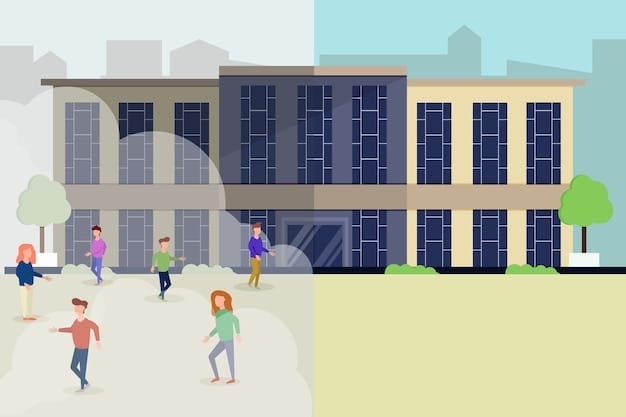US High School Graduation Rate Hits Record 87% – Federal Report

A recent federal report indicates that the US high school graduation rate has reached a historic high of 87%, signaling positive trends in American education.
A groundbreaking federal report has just revealed an unprecedented achievement in American education: the US high school graduation rate has surged to a record-breaking 87%. This landmark figure reflects years of dedication from students, educators, and communities nationwide, marking a significant step forward in educational attainment.
Understanding the Record-High Graduation Rate
The newly released federal report sheds light on the remarkable progress made in high school graduation rates across the United States. This achievement is not just a number; it represents countless individual stories of students overcoming challenges and achieving their academic goals.
Key Factors Contributing to the Rise
The upward trend in graduation rates can be attributed to several factors, including targeted educational reforms, increased funding for schools, and innovative programs designed to support struggling students.
- Improved Teacher Training: Enhanced professional development for teachers equips them with the skills to better engage and support students.
- Early Intervention Programs: Identifying and assisting at-risk students early in their academic careers can prevent them from falling behind.
- Community Involvement: Strong community support systems provide students with resources and encouragement to succeed.
These collective efforts have created a more supportive and effective learning environment, leading to higher graduation rates across various demographics.

Demographic Trends in Graduation Rates
While the overall graduation rate has increased, it’s essential to examine how different demographic groups are faring. The report provides valuable insights into the progress made across various racial, ethnic, and socioeconomic backgrounds.
Significant gains have been observed among minority students, particularly Hispanic and African American students, narrowing the achievement gap. However, disparities still exist, highlighting the need for continued focus on equity and inclusion in education.
Areas for Continued Improvement
Addressing the remaining disparities requires a multi-faceted approach, including culturally responsive teaching practices, targeted support for low-income students, and increased access to resources in underserved communities.
- Closing the Achievement Gap: Implementing strategies to ensure that all students, regardless of their background, have equal opportunities to succeed.
- Supporting Low-Income Students: Providing additional resources and support to help students from disadvantaged backgrounds overcome barriers to education.
- Promoting Equity and Inclusion: Creating a learning environment that values diversity and fosters a sense of belonging for all students.
By focusing on these areas, we can continue to make progress towards a more equitable and inclusive education system.
The Impact of Graduation Rates on the Economy
The high school graduation rate has far-reaching implications for the US economy. A more educated workforce translates to increased productivity, higher earnings, and greater economic stability.
Graduates are more likely to secure employment, contribute to the tax base, and participate in lifelong learning, driving economic growth and innovation. Furthermore, a well-educated population is better equipped to adapt to the demands of a rapidly changing global economy.
Long-Term Economic Benefits
Investing in education yields significant long-term economic benefits, including reduced poverty rates, lower healthcare costs, and increased civic engagement.
By prioritizing education, we can create a more prosperous and equitable society for future generations.
Educational Reforms and Their Role
Several educational reforms have played a crucial role in boosting graduation rates. These reforms include initiatives focused on curriculum development, teacher training, and student support services.
The implementation of rigorous academic standards, coupled with personalized learning approaches, has helped to better prepare students for college and careers. Additionally, efforts to reduce class sizes and provide more individualized attention have contributed to improved student outcomes.
Key Reform Initiatives
Examples of successful reform initiatives include:
- Common Core Standards: These standards aim to ensure that students are equipped with the knowledge and skills necessary to succeed in college and careers.
- Personalized Learning: Tailoring instruction to meet the individual needs and learning styles of each student.
- Early College High Schools: These schools allow students to earn college credits while still in high school, increasing their likelihood of college enrollment and completion.
These reforms, when implemented effectively, can have a transformative impact on student achievement and graduation rates.
Challenges and Obstacles Persist
Despite the positive trend, significant challenges and obstacles still hinder progress in some communities. These challenges include high poverty rates, inadequate school funding, and a lack of access to quality educational resources.
Addressing these challenges requires a comprehensive and collaborative approach, involving policymakers, educators, community leaders, and families working together to create supportive learning environments.

Strategies for Overcoming Obstacles
Effective strategies for overcoming these obstacles include:
- Increased School Funding: Providing equitable funding to ensure that all schools have the resources they need to succeed.
- Community-Based Support: Creating partnerships between schools and community organizations to provide students with access to social services, mentoring, and other support programs.
- Parental Involvement: Engaging parents in their children’s education through workshops, volunteer opportunities, and regular communication with teachers.
By addressing these challenges head-on, we can create a more equitable education system that allows all students to thrive.
Looking Ahead: Future of Graduation Rates
The record-high graduation rate is a testament to the hard work and dedication of students, educators, and communities across the country. However, it is essential to maintain momentum and continue striving for improvement.
Looking ahead, we must focus on ensuring that all students have access to high-quality education, regardless of their background or zip code. This requires ongoing investment in schools, innovative approaches to teaching and learning, and a commitment to equity and inclusion.
By embracing these principles, we can build a brighter future for our students and our nation.
The Broader Social Implications of High Graduation Rates
Beyond the economic benefits, high graduation rates significantly influence broader social outcomes. A more educated populace tends to participate more actively in civic life, leading to stronger communities and a more engaged democracy.
Impact on Crime Rates, Health, and Civic Engagement
Education has a direct correlation with several positive societal outcomes:
- Lower Crime Rates: Individuals with higher levels of education are less likely to engage in criminal activities. Education provides skills and opportunities leading to alternative paths.
- Improved Health Outcomes: A better-educated population tends to make healthier lifestyle choices, has better access to healthcare information, and utilizes medical services more effectively.
- Increased Civic Engagement: Educated citizens are more likely to participate in elections, volunteer in their communities, and advocate for positive social change.
Thus, the benefits of enhanced graduation rates reverberate far beyond individual success, positively impacting society as a whole.
| Key Point | Brief Description |
|---|---|
| 🎓 Record Graduation Rate | US high school graduation rate reaches an all-time high of 87%. |
| 📈 Economic Impact | Increased graduation rates lead to a more productive workforce and economic stability. |
| 🤝 Educational Reforms | Reforms like Common Core and personalized learning contribute to improved outcomes. |
| 🍎 Social Benefits | High graduation rates correlate with lower crime, better health, and greater civic participation. |
Frequently Asked Questions
▼
The recent federal report indicates that the US high school graduation rate has reached a record high of 87%, showcasing improvements in the education system.
▼
Several factors, including enhanced teacher training, early intervention programs, and greater community involvement, have played critical roles in boosting graduation rates.
▼
Higher graduation rates contribute to a more educated workforce, leading to increased productivity, higher earnings, and greater economic stability for the country.
▼
Reforms such as Common Core standards, personalized learning approaches, and early college high schools have all contributed to improved student outcomes and higher graduation rates.
▼
High graduation rates correlate with lower crime rates, improved health outcomes, and increased civic engagement, leading to stronger communities and a more active democracy.
Conclusion
The record-high US high school graduation rate of 87% signifies progress and underscores the significance of continuous investment in education, support for students, and community involvement. As we celebrate this achievement, it’s important to focus on tackling persistent challenges and striving for further improvements for all students.





